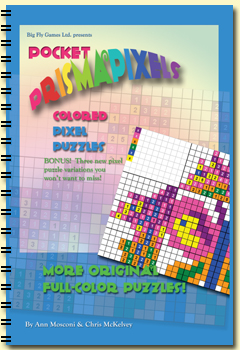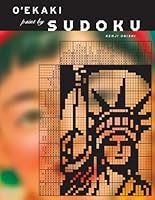They go by many names: Paint by Numbers, Nonograms, Hanjie, O’ekaki, PrismaPixels and countless others. They are all done by or based on a type of puzzles by puzzle master Tetsuya Nishio from Japan. I first discovered O’ekaki in Games Magazine a decade or two ago. I fell in love instantly. I couldn’t get enough.
One or two of these puzzles in the magazine each month didn’t satisfy me, so I was delighted when Games put out a whole book of them. I devoured it. Occasional mistakes set me back a bit, and made it important to do the puzzles in pencil. I finished the book fairly quickly, though, but found that nothing else was available. I did eventually find a website or two that offered the puzzles online, but doing them online wasn’t portable. It was hard to curl up with them in bed at night.
Fortunately, there must have been others out there like me who couldn’t wait for more puzzles. A couple of years ago I found another set of books by the original inventor, Tetsuya Nishio. That set has now been expanded to four volumes: O’ekaki: Paint By Sudoku, More O’Ekaki: Paint by Numbers From Its Inventor
, Original O’ekaki: Intelligent Designs from Its Creator
and the newest one O’ekaki Heaven
.


Despite still working my way through Nishio’s set of books, I keep my eye out for other books like these. About a month ago, I discovered a brand new take on the puzzles. Color! Ann Mosconi and Chris McKelvey have created two books of puzzles very similar to the original O’ekaki puzzles, PrismaPixels and Pocket PrismaPixels
. The addition of the dimension of color adds a new challenge. If you only use the logic tests that are used for the single color puzzles, the multicolored ones will take much longer to complete. Once you figure out how to use the logic of the colors to eliminate possible boxes, it gets much easier. The rules are basically the same as for the single color puzzles, and most of the same principles apply, but there is a slight difference. This difference has made me make multiple mistakes, since I’ve been doing the single color ones for so many years.
Both PrismaPixels books are wire-o bound for laying flat. That feature is quite handy when you are juggling several colored pencils. Adding color to the puzzles adds a whole new complexity, both in keeping colors straight, and in added clues to what color squares are to be filled in on each row. The only negative thing I can say is that some of the puzzles use colors that are quite similar to each other, and it is often hard to keep them straight. But if you have been a fan of the single color O’ekaki puzzles and want a new challenge or another couple of books to devour, they are well worth having. If you haven’t tried these puzzles before, PrismaPixels is a great place to start. An extensive set of colored pencils is highly recommended. TIP: Try to find the erasable kind.
While O’ekaki puzzles have recently been compared to Sudoku, they have little in common. Other than the fact that they both use a grid and numbers are involved, the puzzle types are nothing alike. O’ekaki puzzles use number logic and coloring in squares to slowly reveal a picture. While some of the puzzle books have clues that allude to the nature of the final picture, some do not.
In addition to the books I mention above, there has been a slew of new O’ekaki-type puzzle books in the past several years. Including the above books, I count at least 13 currently available. I highly recommend these puzzles in general, and all books by Tetsuya Nishio and the PrismaPixel books in particular. Two big geeky thumbs up!
(Image: Big Fly Games)

![Reblog this post [with Zemanta]](http://img.zemanta.com/reblog_e.png?x-id=da789aa4-58df-494b-be89-f8abcb9a71f7)

